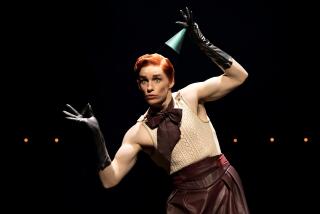Dreamlands for Our Critics : If you could enjoy your favorite pastime anywhere, where would it be? Calendar’s film, music, pop, theater, art and TV critics reveal their wishes. : Where Everything’s Brighter, Elegant
Oh, to be in Munich. . . .
The population of this stubbornly gemutlich yet quietly sophisticated city on the Isar numbers about 1.3 million. That makes it just a bit more crowded than metropolitan San Diego.
Munich is proud of its beer and its Oktoberfest, and even prouder, perhaps, of its music. The Bavarian capital hosts three decent symphony orchestras. Chamber music is taken very seriously here, and international recitalists constantly parade through town.
Still, the main attraction for most natives--including this one, who left long, long ago at the age of 3--remains opera.
The big works are performed by international casts at the National Theater. Wagner’s “Tristan” and “Meistersinger” received their premieres in this magnificent edifice, slowly rebuilt after World War II. Seating 2,000, it really isn’t big at all by American standards.
Operettas, musical comedies and relatively folksy operas are presented nightly at the lovely old Gartnerplatz Theater. Performances by the modest resident ensemble are usually more notable for charm than for finesse. No one complains. The auditorium accommodates only 930.
Munich’s historic jewel remains the Altes Residenz Theater, a.k.a. Cuvillies Theater. A model of inspired rococo excess, it seats only 442. Singers need not force for impact in a house where a whisper can mean as much as a roar, and where the raising of an eyebrow has the impact of a heroic gesture.
Francois Cuvillies built the tiny theater, an integral part of the electoral palace, in 1753. Mozart oversaw the first performance of his “Idomeneo” here in 1781. Richard Strauss often conducted “Cosi fan tutte” here, sometimes adding autobiographical quotations to the continuo part. His own “Intermezzo,” “Capriccio” and “Ariadne” are ideally suited to the intimate sight and sound lines.
The Residenz Theater was painstakingly dismantled early in the Nazi regime, the interior components hidden in the countryside. The exterior walls were bombed in March, 1944. Impeccably reconstructed on a site near the original location, the theater finally rose like a courtly phoenix from its own ashes on June 12, 1958. The bill on that unforgettable night was “Die Hochzeit des Figaro.” I was lucky enough to be there.
Attending a performance here is an Event. Capital E. There is no better place in the world to hear Mozart.
Just look around. Intricate chandeliers glitter in the gold, ivory and--I think--raspberry auditorium. Delicately carved cherubs float atop the proscenium, blowing festive horns. Everything looks a little brighter than normal, a little more elegant.
Just listen. Every tone rings with special warmth, with uncommon grace and clarity. Everything sounds mellow. The music is at home here.
In Munich, the scale is human.
More to Read
The biggest entertainment stories
Get our big stories about Hollywood, film, television, music, arts, culture and more right in your inbox as soon as they publish.
You may occasionally receive promotional content from the Los Angeles Times.










